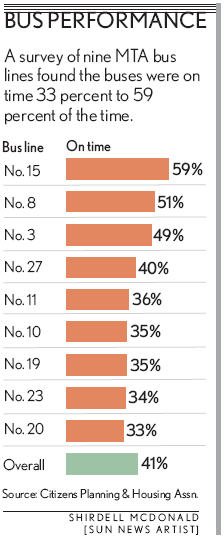Two more (transit) examples of why who gets elected matters (Maryland)
 Baltimore Sun graphic.
Baltimore Sun graphic.1. From the Baltimore Sun article, "Political clash results in 2 Red Line panels":
The Maryland Transit Administration will have two distinct advisory committees on the proposed east-west Red Line through Baltimore after legislators voted early yesterday to override the governor's veto of their plan to appoint an oversight panel. The governor has created his own panel by executive order.
The legislature overrode the veto of the bill - which creates a 15-member advisory panel largely chosen by General Assembly leaders and legislators from the affected districts - on mostly party-line votes in the Senate and House of Delegates. It was one of two transportation-related vetoes overridden during this week's special session.
The Red Line bill passed both houses by overwhelming margins during the regular 90-day legislative session. Last month, Ehrlich vetoed the measure and created his own advisory committee on the proposed Canton-to-Woodlawn transit line - all gubernatorial appointees - by executive order.
Transportation Secretary Robert L. Flanagan said yesterday that Ehrlich would not abandon his plan to create his own panel. "We've already got a group of citizen activists and community representatives who have agreed to serve," Flanagan said. "The happiest outcome will be that the two panels will work together and see eye to eye on what the issues are."
But the legislators who chair the House and Senate committees that recommended the overrides disagreed. "It sounds dysfunctional," said Del. Maggie L. McIntosh, chairwoman of the House Environmental Committee.
2. Also from the Sun, "MTA buses fail on-time tests":
Despite a recent overhaul of routes and schedules, Maryland Transit Administration buses show up on schedule less than half the time, according to a survey to be released today by a community watchdog organization. The survey by the Citizens Planning and Housing Association found that only 41 percent of buses on nine routes in the Baltimore area arrived within the window used by the MTA to define a bus that is on schedule. A bus is not considered on time if it is more than 5 minutes late or more than one minute early.
About 29 percent of buses arrived late, while another 29 percent came early - potentially leaving on-time passengers waiting for the next scheduled bus, the planning group said. The survey's lead author, CPHA regional policy director Dan Pontious, called the results "very disappointing."
Click here, "Bus route changes," for more Sun coverage of the Greater Baltimore Transit Initiative.
3. Extra credit would be the Inter County Connector toll road, which will capture most of the federal monies awarded to Maryland for transportation for the next decade ("Interesting difference of opinion between the Baltimore Sun and the Washington Post on the Inter County Connector"), instead of more transit, and the Ehrlich Administration's hardball tactics in an attempt to get approval to change bus routing without public hearings ("We do what we should have done, you do this for us (MTA transit)").
 Transportation Secretary Robert L. Flanagan (left) talks to Ronald Epps of Reservoir Hill on the No. 13 bus during a three-hour tour that let passengers tell him what they thought of the overhaul. (Sun photo by Amy Davis) Feb 2, 2006
Transportation Secretary Robert L. Flanagan (left) talks to Ronald Epps of Reservoir Hill on the No. 13 bus during a three-hour tour that let passengers tell him what they thought of the overhaul. (Sun photo by Amy Davis) Feb 2, 2006Index Keywords: transit



0 Comments:
Post a Comment
<< Home